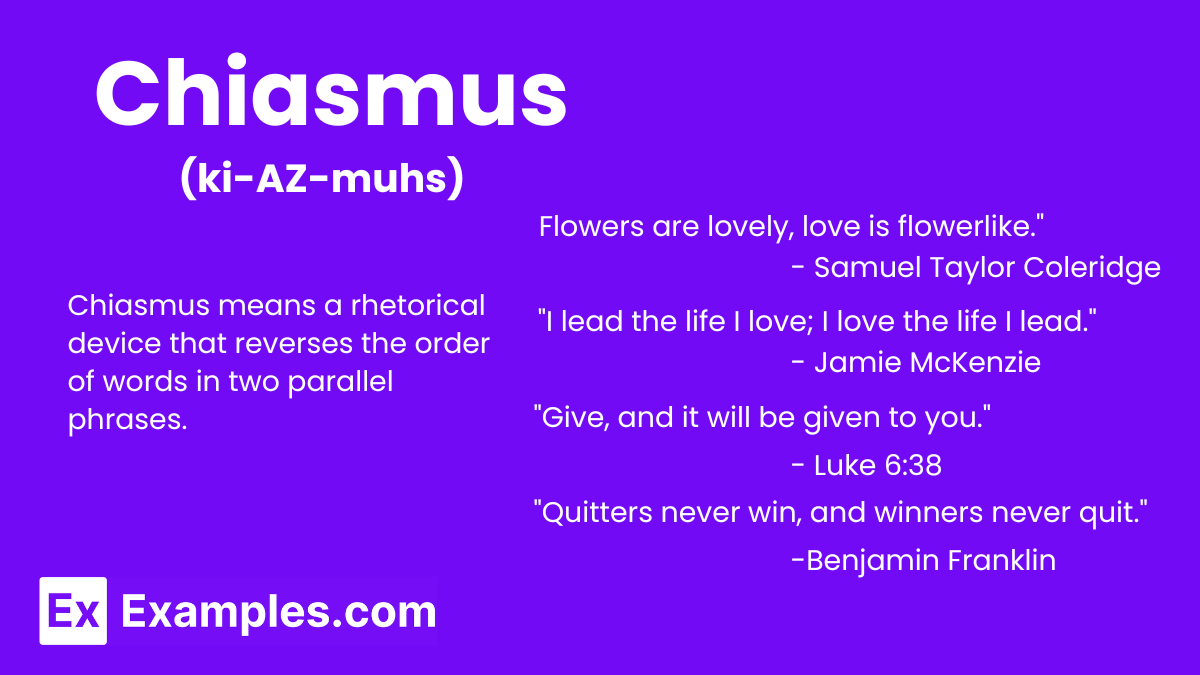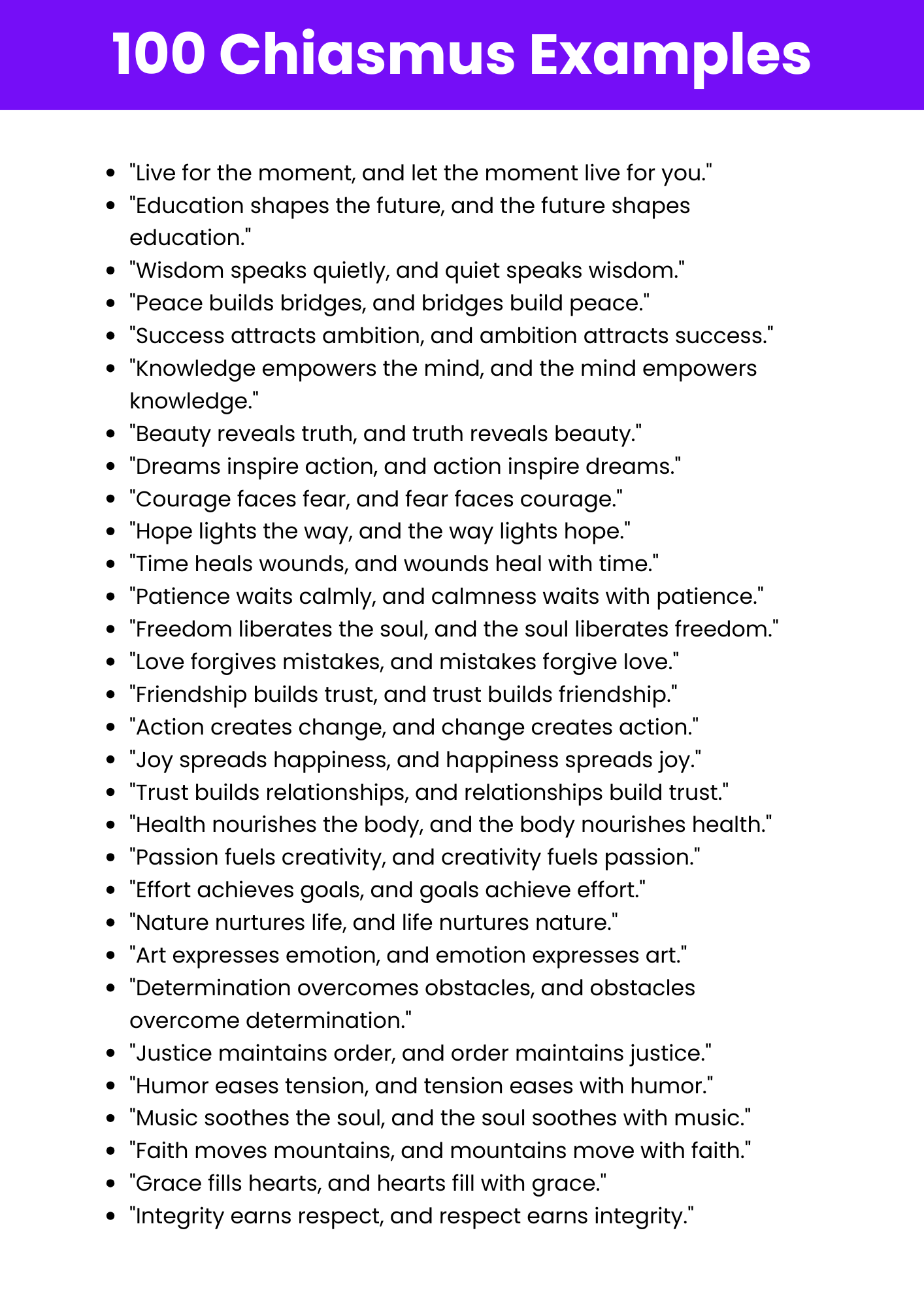Chiasmus
What is Chiasmus? – Definition
Chiasmus is a rhetorical device in which two or more clauses are balanced against each other by the reversal of their structures. It is used to create emphasis, make statements more memorable, and enhance the rhythmic quality of language.

Generated Chiasmus Examples

Download Chiasmus Examples
Enhance your understanding with our comprehensive PDF guide.
Download PDFExamples of Chiasmus
- She sells seashells by the seashore, and the seashore sells her seashells.
- He was brave in battle, and battle was brave to him.
- Light is the key to vision, and vision is the key to light.
- The teacher teaches wisdom, and wisdom teaches the teacher.
- Dreams fuel the imagination, and imagination fuels the dreams.
- Success builds confidence, and confidence builds success.
- Music soothes the soul, and the soul soothes the music.
- Nature nurtures the spirit, and the spirit nurtures nature.
- Books expand knowledge, and knowledge expands through books.
- Time heals wounds, and wounds heal over time.
- Hope lights the darkness, and darkness hides hope.
- Wisdom guides the journey, and the journey guides wisdom.
- Patience calms the mind, and the mind calms with patience.
- Faith sustains the weary, and the weary are sustained by faith.
- Silence speaks volumes, and volumes speak through silence.
- Courage confronts fear, and fear confronts courage.
- Honesty builds trust, and trust builds honesty.
- Art expresses emotion, and emotion expresses through art.
- Friendship strengthens bonds, and bonds strengthen friendship.
- Leadership inspires action, and action inspires leadership.
- Knowledge illuminates the path, and the path illuminates knowledge.
- Love conquers hate, and hate conquers love.
- Change shapes destiny, and destiny shapes change.
- Health empowers life, and life empowers health.
- Passion ignites creativity, and creativity ignites passion.
- Freedom liberates the mind, and the mind liberates freedom.
- Justice serves the community, and the community serves justice.
- Growth fosters resilience, and resilience fosters growth.
- Kindness spreads warmth, and warmth spreads kindness.
- Balance sustains harmony, and harmony sustains balance.
Types of Chiasmus
Antimetabole
A specific type of chiasmus where the exact same words are repeated in reverse order in the second clause.
- Fair is foul, and foul is fair.
- Ask not what your country can do for you; ask what you can do for your country.
- All for one, and one for all.
- I know what I like, and I like what I know.
- You can take the boy out of the country, but you can’t take the country out of the boy.
Semantic Chiasmus
Involves the reversal of concepts or meanings rather than the exact words, focusing on the underlying ideas.
- Make war against hate, and love against war.
- You have the right to free speech, but you also have the responsibility to speak.
- To be free is not merely to cast off one’s chains, but to live in a way that respects and enhances the freedom of others.
- Don’t ask what the world needs; ask what makes you come alive, and go do it.
- We do not inherit the Earth from our ancestors, we borrow it from our children.
Nested Chiasmus
Contains multiple chiasmi within a larger structure, creating a layered or complex mirrored effect.
- When the sun rises, the shadows fall; when the shadows fall, the sun rises.
- She loves him, not for who he is, but for who she is when she is with him.
- The king reigns, the realm remains; the realm remains, the king reigns.
- In the night sky, stars shine bright; in the bright light, stars in the night sky.
- He builds his dreams with hope; hope builds his dreams with him.
Balanced Chiasmus
Features parallelism where two segments are of equal length and balanced in structure, enhancing the symmetry of the statement.
- Rise early and work hard; work hard and rise early.
- Success is not final, failure is not fatal: It is the courage to continue that counts.
- To be loved is great, but to love is greater.
- Let us never negotiate out of fear, but let us never fear to negotiate.
- He who controls the past controls the future; he who controls the future controls the past.
Recursive Chiasmus
A chiasmus that repeats the chiastic structure within itself, creating a recursive or self-referential pattern.
- All I know is that I know nothing.
- Who can say where the mind ends and the body begins?
- It is what it is.
- Life is not a problem to be solved, but a reality to be experienced.
- The art of living is more like wrestling than dancing.
Thematic Chiasmus
Centers around a specific theme or subject, using the chiasmus structure to highlight contrasts or complementarities within that theme.
- Love conquers all; let us too surrender to love.
- Knowledge is power; power is knowledge.
- Freedom without responsibility is meaningless; responsibility without freedom is tyranny.
- Peace begins with a smile; a smile begins with peace.
- Truth is simplicity; simplicity is truth.
Inverted Chiasmus
Reverses the usual order of words or concepts to create emphasis or highlight contrast.
- The first shall be last, and the last shall be first.
- Not my will, but yours be done.
- Out of the frying pan and into the fire.
- He was alive through death; death through life.
- The beginning of the end, the end of the beginning.
Rhetorical Chiasmus
Used primarily in speeches and persuasive writing to reinforce a point through a mirrored structure.
- Let us go forward together, or let us go backward alone.
- Ask not what your country can do for you; ask what you can do for your country.
- To conquer fear is the beginning of wisdom; to understand wisdom is to conquer fear.
- We shape our buildings; thereafter, they shape us.
- He who hesitates is lost; he who acts is remembered.
How to Identify/Find Chiasmus?
To identify chiasmus, look for phrases where the structure of the first part is mirrored or inverted in the second part. Chiasmus often highlights contrasts or emphasizes a point through this structural reversal.
- Look for direct structural inversions between clauses or phrases.
- Identify balanced sentence structures that mirror each other.
- Check if the inversion creates emphasis or highlights a contrast.
- Notice if the reversal adds rhetorical strength or memorability.
- Look for chiasmus that is integral to the theme or message.
How to Use Chiasmus?
Use chiasmus to enhance your writing by creating memorable and impactful statements. Ensure your chiasmus is clear and relevant to the subject, avoiding overcomplication to maintain its effectiveness.
- Choose structures that naturally invert to emphasize your point.
- Use concise and balanced phrases for maximum impact.
- Integrate chiasmus seamlessly into your narrative or argument.
- Ensure the inversion enhances the reader’s understanding or emotional response.
- Avoid overusing chiasmus to maintain its effectiveness.
Other Chiasmus Examples
Chiasmus Examples in Literature
Chiasmus used in literature to enhance narratives and character development, creating memorable and impactful phrases.
- To write is to think, and to think is to write.
- In stories we find ourselves, and in ourselves, we find stories.
- Characters shape the plot, and the plot shapes the characters.
- Dreams fuel imagination, and imagination fuels dreams.
- Pages turn with time, and time turns with the pages.
Chiasmus Examples in Poetry
Chiasmus in poetry adds rhythm and depth, enhancing the emotional and aesthetic appeal of verses.
- Whispers of the wind, and the wind whispers back.
- Moonlight dances on the sea, and the sea dances under the moonlight.
- Stars glitter in the night, and the night glitters with stars.
- Leaves whisper secrets, and secrets whisper through the leaves.
- Rain kisses the earth, and the earth kisses the rain.
Funny Chiasmus Examples
Humorous chiasmus that bring a smile through witty inversions and playful language.
- I dance to music, and music dances to me.
- Cats chase mice, and mice chase cats.
- I give advice, and advice gives me trouble.
- He cleans his house, and his house cleans him.
- I buy clothes, and my clothes buy my image.
Chiasmus Examples in Songs
Chiasmus in song lyrics to emphasize themes and create memorable hooks.
- You play the game, I play the player.
- I love you more than yesterday, less than tomorrow.
- Sing in the rain, dance in the storm.
- The night is young, the young night is ours.
- Feel the beat of the heart, the heart beats to the rhythm.
Chiasmus Examples in Movies
Chiasmus used in movie dialogues to create impactful and memorable lines.
- The hero saves the day, and the day saves the hero.
- Fight for justice, and justice fights for you.
- Run from danger, and danger runs to you.
- Love conquers all, and all conquers love.
- When you lose, you learn; when you learn, you lose.
Chiasmus Examples in Music
Chiasmus in musical contexts to enhance lyrical and thematic expressions.
- Rhythm moves the body, and the body moves the rhythm.
- Harmony creates balance, and balance creates harmony.
- Beats drive the dance, and the dance drives the beats.
- Melodies sing to the soul, and the soul sings to the melodies.
- Tunes flow with emotion, and emotion flows with the tunes.
Explore Other Literary Devices
Elevate Your AP English Preparation
Unlock your potential with our comprehensive AP English exam preparation tools designed to help you excel.
- Extensive Question Bank: Access 900+ exam-like questions for both AP English Language and Literature.
- Expertly Crafted: Questions mirror the structure and difficulty of actual AP exams, ensuring relevant practice.
- Detailed Explanations: Understand your mistakes with clear, concise breakdowns of correct and incorrect answers.
- Personalized Learning: Tailor your study sessions with topic-specific tests and adaptive learning tools.
- Comprehensive Coverage: Master all aspects of the AP English curriculum with extensive guides and resources.
Frequently Asked Questions
-
What is a chiasmus?
A chiasmus is a rhetorical device where two or more clauses are balanced against each other by the reversal of their structures, enhancing emphasis and creating a memorable effect. -
How does chiasmus differ from other rhetorical devices?
Unlike metaphors or similes that draw comparisons, chiasmus focuses on the structural inversion of phrases or clauses to create balance and emphasize contrasting ideas. -
Why is chiasmus important in writing?
Chiasmus adds depth and rhythm to writing, making statements more impactful and memorable. It enhances the aesthetic quality of language and can effectively highlight contrasts or key themes. -
Can chiasmus be extended?
Yes, extended chiasmus spans multiple sentences or an entire passage, maintaining the inverted structure to reinforce the thematic elements throughout the text. -
How can I effectively create my own chiasmus?
To create effective chiasmus, identify the core ideas you want to emphasize, then structure your sentences so that the second part mirrors or inverts the first part’s structure, ensuring clarity and relevance.

